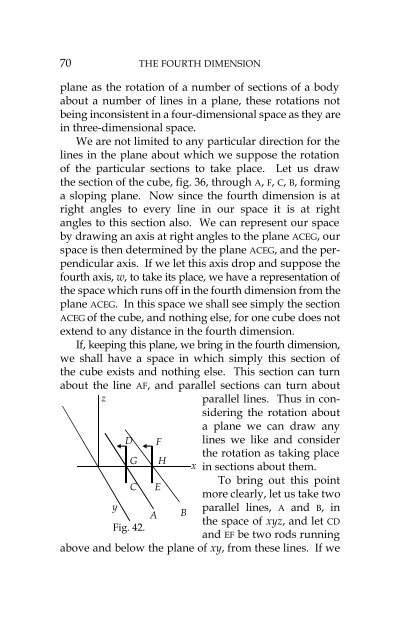You also want an ePaper? Increase the reach of your titles
YUMPU automatically turns print PDFs into web optimized ePapers that Google loves.
70<br />
THE FOURTH DIMENSION<br />
plane as the rotation of a number of sections of a body<br />
about a number of lines in a plane, these rotations not<br />
being inconsistent in a four-dimensional space as they are<br />
in three-dimensional space.<br />
We are not limited to any particular direction for the<br />
lines in the plane about which we suppose the rotation<br />
of the particular sections to take place. Let us draw<br />
the section of the cube, fig. 36, through A, F, C, B, forming<br />
a sloping plane. Now since the fourth dimension is at<br />
right angles to every line in our space it is at right<br />
angles to this section also. We can represent our space<br />
by drawing an axis at right angles to the plane ACEG, our<br />
space is then determined by the plane ACEG, and the perpendicular<br />
axis. If we let this axis drop and suppose the<br />
fourth axis, w, to take its place, we have a representation of<br />
the space which runs off in the fourth dimension from the<br />
plane ACEG. In this space we shall see simply the section<br />
ACEG of the cube, and nothing else, for one cube does not<br />
extend to any distance in the fourth dimension.<br />
If, keeping this plane, we bring in the fourth dimension,<br />
we shall have a space in which simply this section of<br />
the cube exists and nothing else. This section can turn<br />
about the line AF, and parallel sections can turn about<br />
z<br />
parallel lines. Thus in considering<br />
the rotation about<br />
a plane we can draw any<br />
D F lines we like and consider<br />
the rotation as taking place<br />
G H<br />
x in sections about them.<br />
To bring out this point<br />
C E<br />
more clearly, let us take two<br />
y<br />
parallel lines, A and B, in<br />
A B<br />
the space of xyz, and let CD<br />
Fig. 42.<br />
and EF be two rods running<br />
above and below the plane of xy, from these lines. If we






![[PDF] Prolegomena](https://img.yumpu.com/16774951/1/190x245/pdf-prolegomena.jpg?quality=85)









